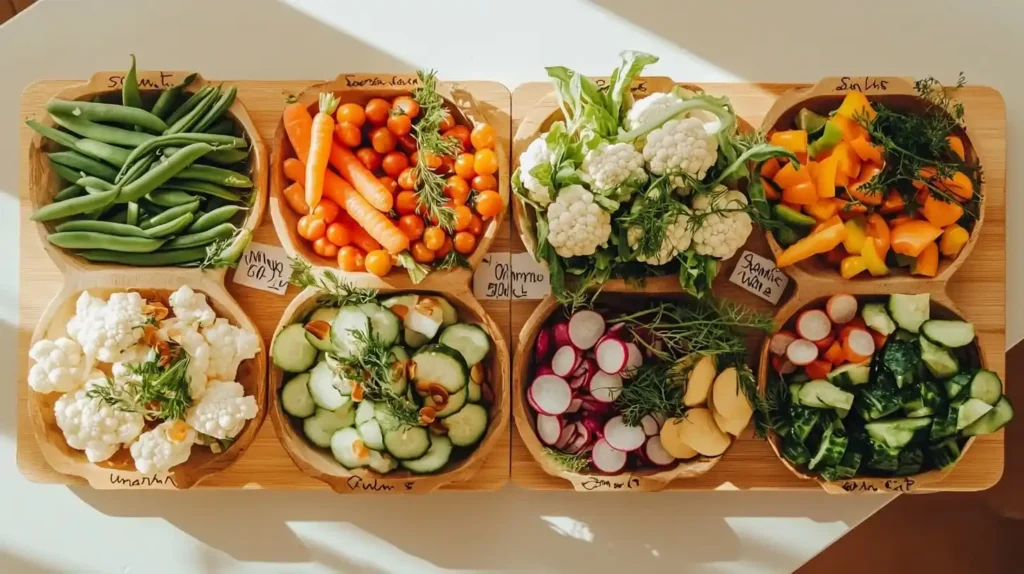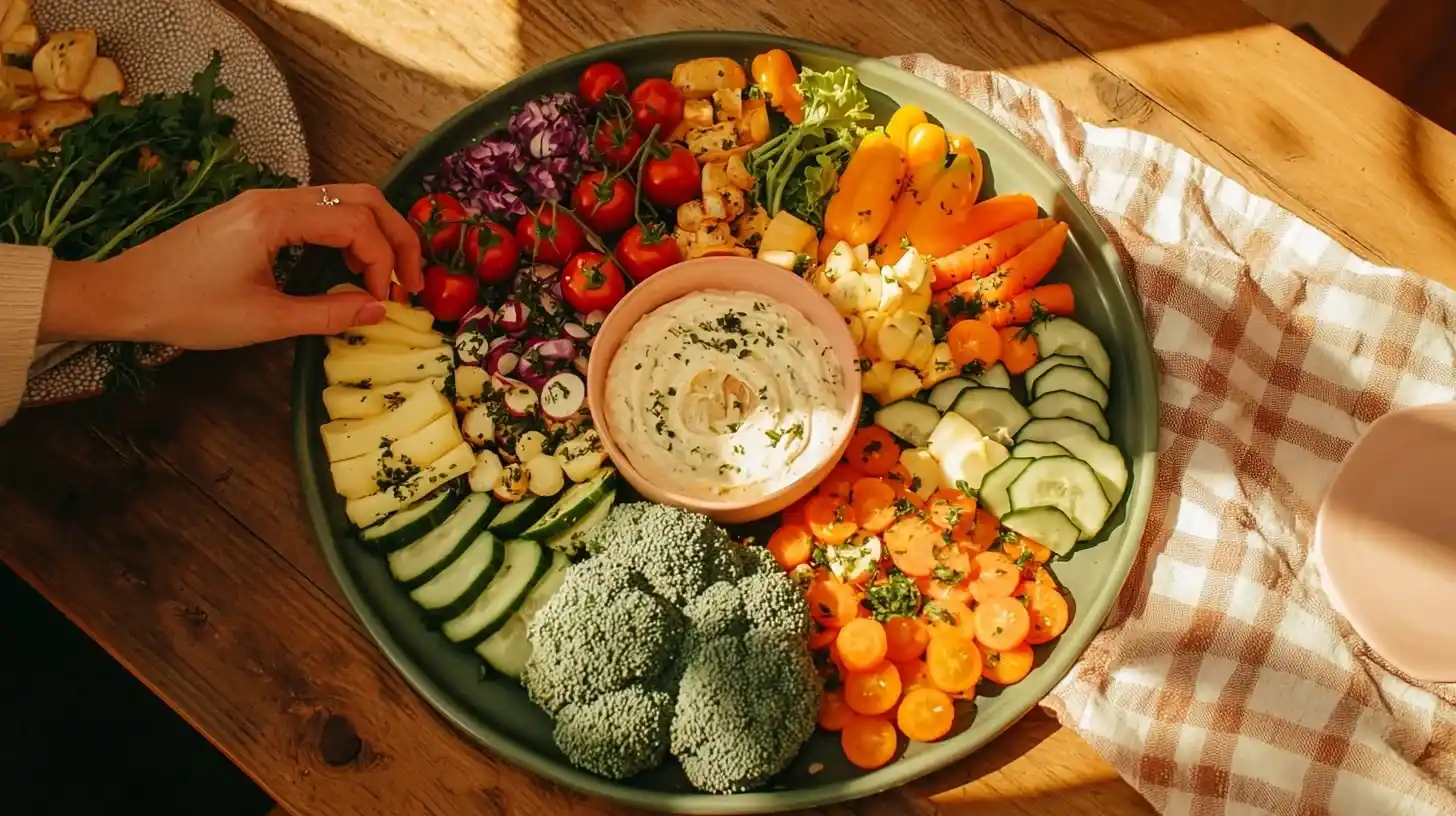“Which vegetables should I include?” This common question crossed my mind during my first attempt at creating a Vegetable Tray for my daughter’s dance recital. Standing in the produce section, overwhelmed by options, I wished for my grandmother’s confident guidance.What Are the Best Veggies for a Veggie Tray?.
Through years of creating vegetable platters for gatherings large and small, I’ve developed clear favorites that consistently delight guests while creating beautiful presentations.
The best vegetables for a tray balance visual appeal, ease of eating, dipping compatibility, and broad appeal – a combination my grandmother intuitively understood when arranging produce from her Kentucky garden.
Table of Contents
What Are the Best Veggies for a Veggie Tray? The Perfect Vegetable Tray Formula

What Are the Best Veggies for a Veggie Tray? The most successful vegetable trays incorporate a specific balance of elements.
My grandmother taught me to include something red, something orange, something green, and something unexpected – a formula that creates visual interest and flavor variety.
The best selections offer different shapes, textures, and flavors while remaining practical for dipping and eating with fingers.
For an impressive arrangement that has guests asking What is a fancy vegetable tray called?, remember that “crudités” simply means thoughtfully selected raw vegetables presented beautifully.
For more colorful, nutritious options beyond vegetable trays, our Fresh & Vibrant Lunch Ideas: Colorful & Nutritious Options collection offers additional inspiration.
Top 12 Best Vegetables for Vegetable Trays
What Are the Best Veggies for a Veggie Tray? These twelve options consistently perform well on vegetable trays for both visual appeal and guest enjoyment:
- Cherry or Grape Tomatoes: These bright red jewels provide juicy sweetness and vibrant color. My youngest calls them “nature’s candy” and they’re often the first vegetable to disappear from our trays.
- Bell Peppers (multiple colors): Sliced into strips, these offer sweet crunch and beautiful color variety. I typically include red, orange, or yellow varieties as they’re sweeter than green.
- Cucumbers: Perfect for slicing into rounds, these provide refreshing crispness and visual contrast. For preparation questions like Do I peel cucumbers for a veggie tray?, I typically use English cucumbers with skin intact or create decoratively striped regular cucumbers.
- Carrots: Whether as sticks, coins, or baby carrots, these provide familiar sweetness and satisfying crunch. My grandmother called these the “gateway vegetable” for reluctant vegetable eaters.
- Broccoli: Small florets offer textural interest and excellent dip-holding capacity. My mother taught me to select heads with tight, dark green florets for the freshest flavor.
- Cauliflower: Available in white, purple, and orange varieties, these create beautiful color and mirror the shape of broccoli. The purple variety has become my children’s favorite for its novelty.
- Sugar Snap Peas: These sweet, crunchy pods are entirely edible and naturally finger-friendly. My youngest initially called these “vegetable cookies” because of their satisfying crunch and sweetness.
- Celery: Despite its simplicity, celery provides height variation and its natural channel shape holds dip effectively. My grandmother called it the “practical backbone” of any vegetable arrangement.
- Radishes: These peppery, crunchy vegetables add unexpected bite and beautiful color. Sliced or served whole with tops as handles, they create visual interest.
- Jicama: Cut into sticks, this crisp, slightly sweet vegetable provides unique texture and neutral flavor. My mother introduced me to this versatile vegetable that pairs beautifully with both savory and spiced dips.
- Endive Leaves: These elegant, boat-shaped leaves can be used as natural dip vessels. My sister calls these “nature’s spoons” for their perfect dip-holding shape.
- Snow Peas: Flat, sweet pods offer delicate crunch and elegant visual appeal. These were my grandmother’s “special occasion” vegetables, reserved for important gatherings.
For families considering cost alongside selection, Is it cheaper to make or buy a veggie tray? offers valuable comparison information that might influence your vegetable choices.
Seasonal Variations for Maximum Freshness
What Are the Best Veggies for a Veggie Tray? Show Seasonal Vegetables Image Keeping it seasonal! The best vegetable tray options change throughout the year – here’s what to choose each season for maximum freshness and value.
The best vegetables for your tray should reflect seasonal availability for maximum freshness and value.
Spring: Highlight asparagus tips, radishes, snap peas, and young carrots. My grandmother called spring “nature’s first fresh offering” after winter’s limited produce options.
Summer: Feature peak-season tomatoes, cucumbers, bell peppers, and zucchini. These summer vegetables offer maximum flavor and affordability during their natural harvest time.
Fall: Showcase broccoli, cauliflower, carrots, and celery. My mother always said fall vegetables have “stood up to the cooling weather, making them sweetly resilient.”
Winter: Include heartier options like watermelon radish, fennel, endive, and colorful root vegetables. These winter staples provide brightness during months when fresh produce selection narrows.
For more comprehensive family meal ideas beyond seasonal vegetables, our Family-Friendly Lunch Recipes: Effortless Meals for Busy Parents collection offers additional inspiration.
Avoiding Common Vegetable Tray Mistakes
Several vegetables that seem like good candidates actually perform poorly on vegetable trays:
Leafy greens wilt quickly and prove difficult to dip. My first attempt at including spinach leaves taught me this lesson through soggy, neglected greens.
Onions, even sweet varieties, can be overpowering and their strong scent can transfer to neighboring vegetables.
Soft vegetables like avocado or ripe tomato slices brown quickly and create messy eating experiences.
Artichokes, while delicious, require too much manipulation for finger-food settings.
My grandmother’s wisdom applies perfectly here: “Choose vegetables that maintain their dignity on a platter for hours.”
Answers to Your Vegetable Selection Questions
Which vegetables are most kid-friendly? Cherry tomatoes, cucumber slices, carrot sticks, and sugar snap peas tend to appeal to children. My middle child initially avoided most vegetables until I created a “color challenge” that encouraged trying each colored vegetable on our tray.
How many different vegetables should I include? For visual interest and variety, aim for 5-7 different vegetables. My grandmother’s rule was “enough variety to be interesting, but not so much that it becomes overwhelming.”
How do I ensure my vegetables stay fresh-looking? Select firm, fresh vegetables and prepare them no more than 24 hours in advance. Store prepared vegetables in containers lined with paper towels to absorb excess moisture.
Creating Veggie Trays Everyone Will Love
The best vegetables for your tray ultimately reflect both personal preference and practical considerations for your specific gathering.
Consider your audience – a children’s party might feature more familiar options, while an adult gathering might include more adventurous choices.
Balance color and texture for visual appeal – aim for representation across the color spectrum for maximum impact.
Include both familiar and unexpected elements to please various preferences while introducing something new.
Remember that freshness trumps variety – better to have fewer perfectly fresh vegetables than many past-prime options.
My grandmother’s approach to vegetable selection reflected her practical Kentucky wisdom: “Choose what’s fresh, what’s pretty, and what people actually eat.”
These twelve vegetable options offer a starting point – adjust based on your specific gathering needs, seasonal availability, and regional preferences to create vegetable trays that delight both the eye and palate.What Are the Best Veggies for a Veggie Tray?.
With warmth, Sophia





